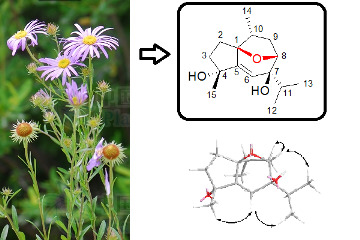A New Sesquiterpene with a Novel 1β, 8β-Oxygen Bridge from Heteropappus altaicus (willd.) Novopokr.
Abstract
:1. Introduction
2. Results and Discussion
3. Experimental
3.1. General
3.2. Plant Material
3.3. Extraction and Isolation
4. Conclusions
Acknowledgements
References and Notes
- Bai, Y.Q. Chinese Medicinal Encyclopidia-The Mongolian Medicine; Science and Technology Press: Shanghai, China, 1990; p. 213. [Google Scholar]
- Ma, Y.Q. The Inner Mogolian Plant Annals; Inner Mogolian People’s Publishing House: Huhhot, China, 2000; p. 494. [Google Scholar]
- Bohlmann, F.; Zdero, C.; Huneck, S. Diterpenes from Heteropappus altaicus. Phytochemistry 1985, 24, 1027–1030. [Google Scholar] [CrossRef]
- Liu, Q.H.; Yang, J.S.; Lu, Y.; Zheng, Q.T.; Mao, L. A new diterpene acid from the flowers of Heteropappus altaicus. Chin. Chem. Lett. 2005, 16, 921–924. [Google Scholar]
- Bader, G.; Tuja, D.; Wray, V.; Hiller, K. New triterpenoid saponins from Heteropappus altaicus (Willd.) Novopokr. and Heteropappus biennis (Ldb.) Tamamsch. Pharmazie 1994, 49, 209–212. [Google Scholar]
- Blohmann, B.; Bader, G.; Hiller, K.; Franz, G. Immunomodulatory and antitumor effects of triterpenoid saponins. Pharmazie 1997, 52, 953–957. [Google Scholar]
- Bader, G.; Seibold, M.; Tintelnot, K.; Hiller, K. Cytotoxicity of triterpenoid saponins-Part 2: Relationships between the structures of glycosides of polygalacic acid and their activities against pathogenic Candida species. Pharmazie 2000, 55, 72–74. [Google Scholar] [PubMed]
- Bader, G.; Tuja, D.; Wray, V.; Hiller, K. Flavonol glycosides from Heteropappus altaicus and H. biennis. Planta Med. 1983, 59, 284–285. [Google Scholar] [CrossRef] [PubMed]
- Jakupovic, J.; Schuster, A.; Bohlmann, F.; Dillon, M.O. Guaianolides and other constituents from Liabum floribundum. Phytochemistry 1988, 27, 1771–1775. [Google Scholar] [CrossRef]
- Blay, G.; Garcia, B.; Molina, E.; Pedro, J.R. Total syntheses of four stereoisomers of 4α-hydroxy-1β, 7β-peroxy-10βH-guaia-5-ene. Org. Lett. 2005, 7, 3291–3294. [Google Scholar] [CrossRef] [PubMed]
Sample Availability: Samples of the compound 4α,7β-dihydroxy-10βH-guai-5-en-1β,8β-endoxide are available from the authors. |



| No. | 1H | 13C |
|---|---|---|
| 1 | - | 88.5 (C) |
| 2 | 2.25 (1H, m); 1.86 (1H, m) | 30.5 (CH2) |
| 3 | 1.94 (1H, m); 1.82 (1H, m) | 39.7 (CH2) |
| 4 | - | 76.7 (C) |
| 5 | - | 153.8 (C) |
| 6 | 5.87 (1H, s) | 122.7 (CH) |
| 7 | - | 74.4 (C) |
| 8 | 4.25 (1H, d, J = 8.0 Hz) | 81.1 (CH) |
| 9 | 2.32 (1H, m); 1.26 (1H, m) | 32.8 (CH2) |
| 10 | - | 42.1 (C) |
| 11 | 1.84 (1H, m) | 30.9 (CH) |
| 12 | 0.92 (3H, d, J = 6.8 Hz) | 16.2 (CH3) |
| 13 | 1.07 (3H, d, J = 6.8 Hz) | 16.5 (CH3) |
| 14 | 0.93 (3H, d, J = 6.8 Hz) | 16.1 (CH3) |
| 15 | 1.36 (3H, s) | 25.6 (CH3) |
© 2011 by the authors; licensee MDPI, Basel, Switzerland. This article is an open access article distributed under the terms and conditions of the Creative Commons Attribution license (http://creativecommons.org/licenses/by/3.0/).
Share and Cite
Han, Y.-F.; Gao, X.-J.; Huang, H. A New Sesquiterpene with a Novel 1β, 8β-Oxygen Bridge from Heteropappus altaicus (willd.) Novopokr. Molecules 2011, 16, 518-522. https://doi.org/10.3390/molecules16010518
Han Y-F, Gao X-J, Huang H. A New Sesquiterpene with a Novel 1β, 8β-Oxygen Bridge from Heteropappus altaicus (willd.) Novopokr. Molecules. 2011; 16(1):518-522. https://doi.org/10.3390/molecules16010518
Chicago/Turabian StyleHan, Yi-Feng, Xiao-Jing Gao, and Hai Huang. 2011. "A New Sesquiterpene with a Novel 1β, 8β-Oxygen Bridge from Heteropappus altaicus (willd.) Novopokr." Molecules 16, no. 1: 518-522. https://doi.org/10.3390/molecules16010518





